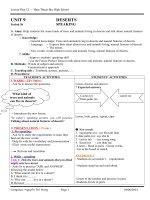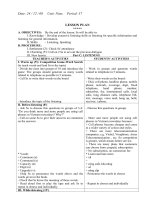Unit 9 - Listening - NTH
Bạn đang xem bản rút gọn của tài liệu. Xem và tải ngay bản đầy đủ của tài liệu tại đây (128.12 KB, 3 trang )
Lesson Plan 12 – Ham Thuan Bac High School
UNIT 9 DESERTS
Period 57 LISTENING
A. Aims: By the end of the lesson, the students will be able to:
- To practice students’ speaking and listening skills.
- To help students to guess the meaning of some words and do the task given in order to
understand the listening about deserts
- 1. Knowledge: - General knowledge: Listen for specific details
- Language: The present future tense.
- New words: Words related to the topic.
2. Skills: - Listening and deciding on True or False statements.
- Listening comprehension through questions
B. Methods: Integrate, Communicative approach
C. Teaching aids : Textbook, posters….
D. Procedures:
TEACHER’S ACTIVITIES STUDENTS’ ACTIVITIES
I. WARM – UP ( 5 min.)
- Asks Ss to discuss some questions.
1. How is the weather in deserts?
2. What animals/ trees can live in deserts?
3. How is sand? How about the rocks?
4. Questions in textbook
→ Lead in " Our lesson today will focus on some
features of deserts and how they are formed "
II. PRESENTATION ( 35 min.)
1. Pre-listening
Listen and repeat
-Ask Ss to listen to the T’s pronunciation and repeat
- incredible (a) - - centenarian (n)
- life expectancy (n) - - fatal (adj.)
- eradicated (a) - - eternal life (n):
- Explains unfamiliar words to students
2. While – listening:
You will hear an expert talking about deserts, what they
are and how they are formed.
* Task1: Decide whether the statements are true (T) or
false (F)
- Ask students to read through the statements and
underline key words.
- Ask Ss to guess whether the statements are true or false.
- Play the tape two times
- Ask Ss to do individually then exchange the answer.
- Play the tape again, have students listen and check the
answers by giving their ideas.
- Checks and gives feedback.
- Ss pay attention to Teacher and find out the
correct answers.
Expected answers:
1. It is very hot.
2. Camels, cactus…
3. It is dry, hot. The rocks are hard …
4. Answers ….
- Write down and repeat
New words
1- agent (n)
2- cool (v)
3- needle( n)
- Read through the statements and underline key
words
- Listen to the tape
- Do the task individually and compare the
answers
Feedback1: Listen and choose True/ False
1 2 3 4 5
T F T F T
- Read through the statements and underline the
key words
- Listen to the tape
- Do the task individually and compare the
answers
Composer: Nguyeãn Thò Höng Page 1 05/06/2013
Lesson Plan 12 – Ham Thuan Bac High School
* Task2: a/ Listen again and answer the questions
- Ask students to read through the questions.
- Play the tape again
- Ask Ss to do the task in groups.
- Ask Ss to present their answers on their sub-ordinate
boards and then tick them on the board.
- Play the tape and correct the structure, words …
- Checks and gives feedback.
* Task3: Fill in the missing word(s)
- Explain the task
- Let Ss read the passage and find the right words to fill in
- Play the tape once more
- Ask Ss to compare the answers with their partners.
- Check the answers with the whole class.
3. Post – listening :
Work in groups: Ask students to Summarize the main
ideas of the experts. Use the following guidelines:
+ definition of deserts
+ the reason for the growth of the deserts
+ the things people should do and shouldn’t do to prevent
the growth of the deserts……
- Go around and offer to help if necessary.
- Call some Ss to present in front of the class.
- Correct and give comment
III. CONSOLIDATION & HOMEWORK (5')
- Prepare part D - WRITING
Feedback2: a. Expected answers
1. It examines deserts, what they are and how
they formed.
2. It is a hot, dry, sandy place. It is also a
beautiful land of silence and space. The sun
shines, the wind blows, and time and space
seem endless
3. Nature and humans.
4. They contribute by eating every plant they
can find. This makes the land becomes desert.
Feedback 3:
1. 90 percent (%)
2. smaller
3. prevent
4. spreading
5. capital
6. canals
3. Post – listening :
- Ss do in groups
- Present in front of class
Goodbye!
Experience: Multiple choice (handouts)
1. The talk examines….what they are and how they are formed.
a. deserts b. animals c. sand
2. Desert is a hot, dry,……..place.
a. peaceful b. endless c. sandy
3. Desert is also a beautiful land of……….space.
a. nature b. silence c. mountains
4. …… and …cause the growing of the world’s deserts.
a. Nature and animals. b. Animals and humans c. Nature and humans
5. Rabbits contribute to the growing of deserts in Australia by…………
a. eating every plant they can find b. cooling the land c. drinking a lot of water
Tape – Script: Unit 9: DESERTS
Hello everyone. In today's talk, I'm going to tell you something about deserts, what they are and how
they are formed.
A desert is a hot, dry, sandy place. A desert is also a beautiful land of silence and space. The sun
shines, the wind blows, and time and space seem endless. Nothing is soft. The sand and the rocks are hard, and
many of the plants, such as the cactus, have hard needles instead of leaves.
Composer: Nguyeãn Thò Höng Page 2 05/06/2013
Lesson Plan 12 – Ham Thuan Bac High School
The size and location of the world's deserts are always changing. Over millions of years, as climates change
and mountains rise, new dry and wet areas develop. But within the last 100 years, deserts have been growing at
a frightening speed. This is partly because of natural changes, but the greatest desert makers are humans.
In the 19
th
century some people living in English colonies in Australia got rabbits from England. Today
there are millions of rabbits in Australia, and they eat every plant they can find. The great desert that covers the
centre of Australia is growing.
Farming first began in the Tigris-Euphrates, but today the land there is a desert. In dry areas, people
can plant crops on dry and poor land. When there are one or two very dry years, the plants die, and the land
becomes desert.
In developing countries, 90 percent of the people use wood for cooking and heat. They cut down trees
for firewood. But trees are important. They cool the land under them and keep the sun off smaller plants. When
leaves fall from a tree, they make the land richer. When the trees are gone, the smaller plants die, and the land
becomes desert.
Humans can make deserts, but humans can also prevent their growth. Algeria planted a green wall of
trees across the edge of the Sahara to stop the desert sand from spreading. Mauritania planted a similar wall
around its capital. Iran puts a thin covering of petroleum on sandy areas and plant trees. Other countries build
long canals to bring water to the desert areas.
Well, that's all for my talk. Thank you for listening..
Composer: Nguyeãn Thò Höng Page 3 05/06/2013









